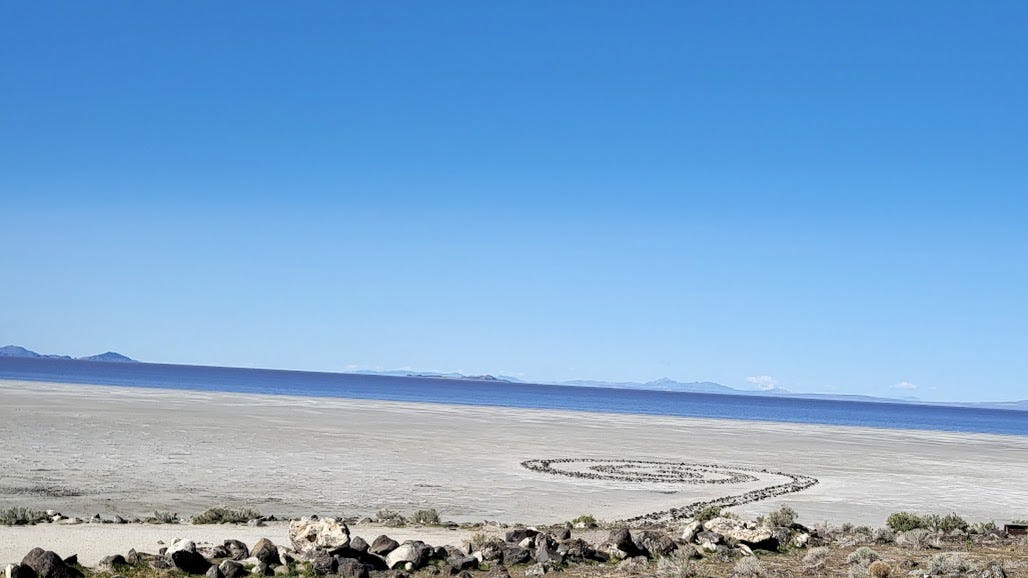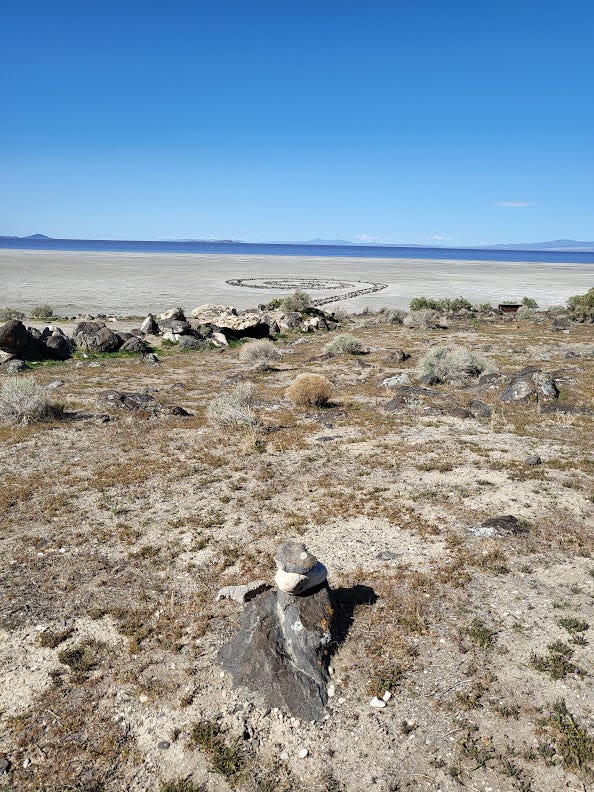A natural story at Spiral Jetty
Our hero journeys to Utah to see art interacting with nature, and story interacting with both
I didn’t want to walk on the jetty—and that surprised me. Although most jetties serve a functional purpose as a breakwater, we typically encounter them as ways to walk on water. But with the lakeshore more than a half-mile away, this jetty was surrounded by sand. And that hardpacked sand was much easier to walk on than three-inch-high pointy rocks poking unevenly out of it.
In 1970, sculptor Robert Smithson built a 1500-foot jetty on a remote northeastern shore of Utah’s Great Salt Lake. It was clearly art: a jetty coiled into a spiral serves no useful purpose. At the time, it was often submerged under the lake, which made it simultaneously even less useful and even more “art.” It was a landmark of the land art movement, which was tied to ecological awareness as it protested the commercialization of the art world.
I arrived at Spiral Jetty, in April 2022, as a skeptic of land art. The movement feels to me like yet another attempt by egocentric white males to impose their will, and their stories, on a landscape. It’s often a landscape they don’t know well—Smithson was from New Jersey. How did he choose this spot? Because it was on an existing dirt road? Because it was somewhat near an underdeveloped tourist attraction called the Golden Spike? Because the land was cheap? If so, then how could any of this be protesting commerce?
Meanwhile, the scale of land art makes it expensive to create. Smithson hired trucks from Ogden to haul rocks and disturb a once-pristine shoreline. Wealthy patrons covered the cost, but after they lost interest in land art in the mid-70s, the movement stalled—thus suggesting it was consumed by the very commercialization it claimed to stand against.
Couldn’t we instead be happy with nature’s own natural stories? Why should we listen to Smithson rather than the undisturbed shoreline?
But I had to admit that my visit, on a cool clear Sunday morning, was a memorable experience. A jetty in the desert is a vivid artifact, a fascinating demonstration of climate change. Back when the jetty was often under water, it was always changing. But now it’s always changing too, as sand blows in and fills the gaps between the basalt rocks. You could call it Iceberg Jetty, with only the tips visible but most of the mass under the surface. Or you might muse on how time has turned Smithson into an Impressionist, because you have to step back from the random dots in order to see the pattern.
Indeed, in my visit Spiral Jetty did its job as modern art, prompting me to ask questions of philosophy and semiotics: what is art? lake? desert? jetty? signifier and signified? time and space?
At first I thought this was a criticism: I was actually more fascinated by an old pier a half-mile east. The pier sat forlorn, equally awkward in the sand. But it had clearly once served a purpose. It was straight, not spiral. It had thus once been useful.
Later, I had to admit that my fascination with the pier arose from its proximity to Spiral Jetty. The art had put me in the right mood to ask big questions. The biggest: What, if anything, could transform this pier, too, into art?
The answer, I believe, is story. We know that Spiral Jetty is art because we know Smithson’s story. (He even made a film of its construction.) If someone were to tell a compelling story of that abandoned pier, it too would be art. And the lake, the desert, the wildlife, the minerals, the nature…
Natural stories. Natural art.
Discussion:
The Dia Art Foundation is the owner and steward of Spiral Jetty. It’s free to visit, but a long dirt road with no facilities at the destination.
Thanks to all who have pledged support for Natural Stories! I have now turned on the payment option. I hope others will support my writing by becoming paid subscribers.
This transition was aided by your thoughts on last month’s survey. (Thanks!) You can see the results on the poll itself, but the lessons I took were to keep writing informative stories of varying lengths, continue mixing memoir and reportage, focus more on storytelling than community-building, and provide lots of free content even to non-paying subscribers.
I’d welcome your comments on land art, art-as-story, and nature-as-story.







"Couldn’t we instead be happy with nature’s own natural stories? Why should we listen to Smithson rather than the undisturbed shoreline?"
Isn't Smithson, the artist, a product of nature (as is Clayton, the artist writing this excellent little story). making this art just as "natural" as the shoreline?
What he did was a "disturbance" by definition. But isn't the history of that shoreline, even more than most places, a history of disturbances as the lake has receded and filled again over time? And isn't this just one more, as was the construction of the pier you saw or the railroad causeway that altered the lake long ago?
Philosopher John Dewey says that human experience (and he definitely does not confine this to those who see themselves or are seen by others as artists) ends (or at least should end) in art. Untangling what that means isn't easy, but what I have been wondering about lately is time. How long did it take Smithson to build the jetty?
Economics (as normally practiced) asks how many commercially marketable widgets could he have manufactured in the same time, and that puts us all on a certain rather sad path. But the jetty and the elaborate quillwork I recently saw on a parfleche at the Eitlejorg Museum suggest another path. Unlike the jetty, the parfleche is inarguably utilitarian. But it would have held whatever it held in its working days just as well without any decoration. Why spend what has to have been many hours adding the quillwork? Is it possible that that is what's "natural?" I know that I like a vision of life in which the jetty and the quillwork are what counts.
Great story. Interesting read!